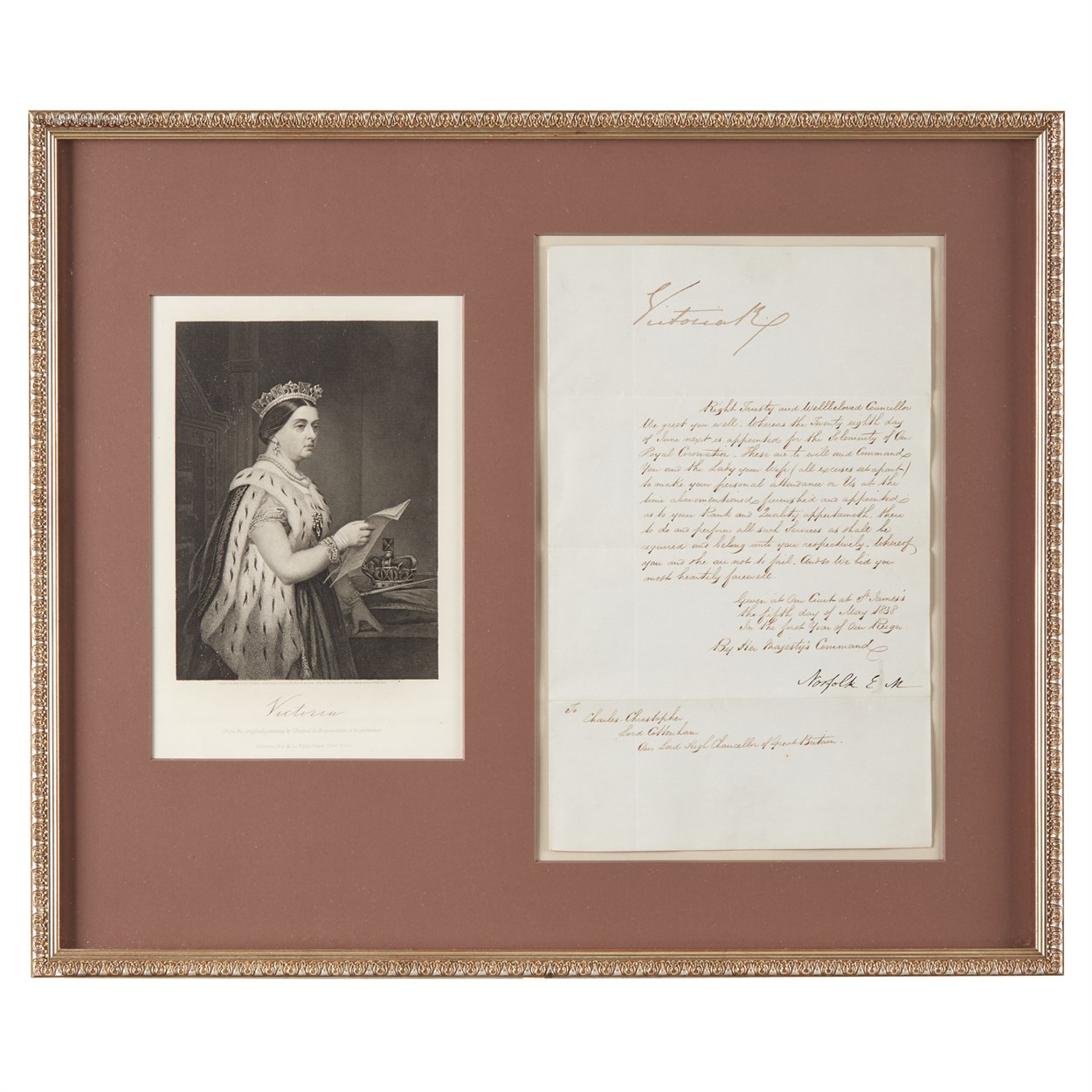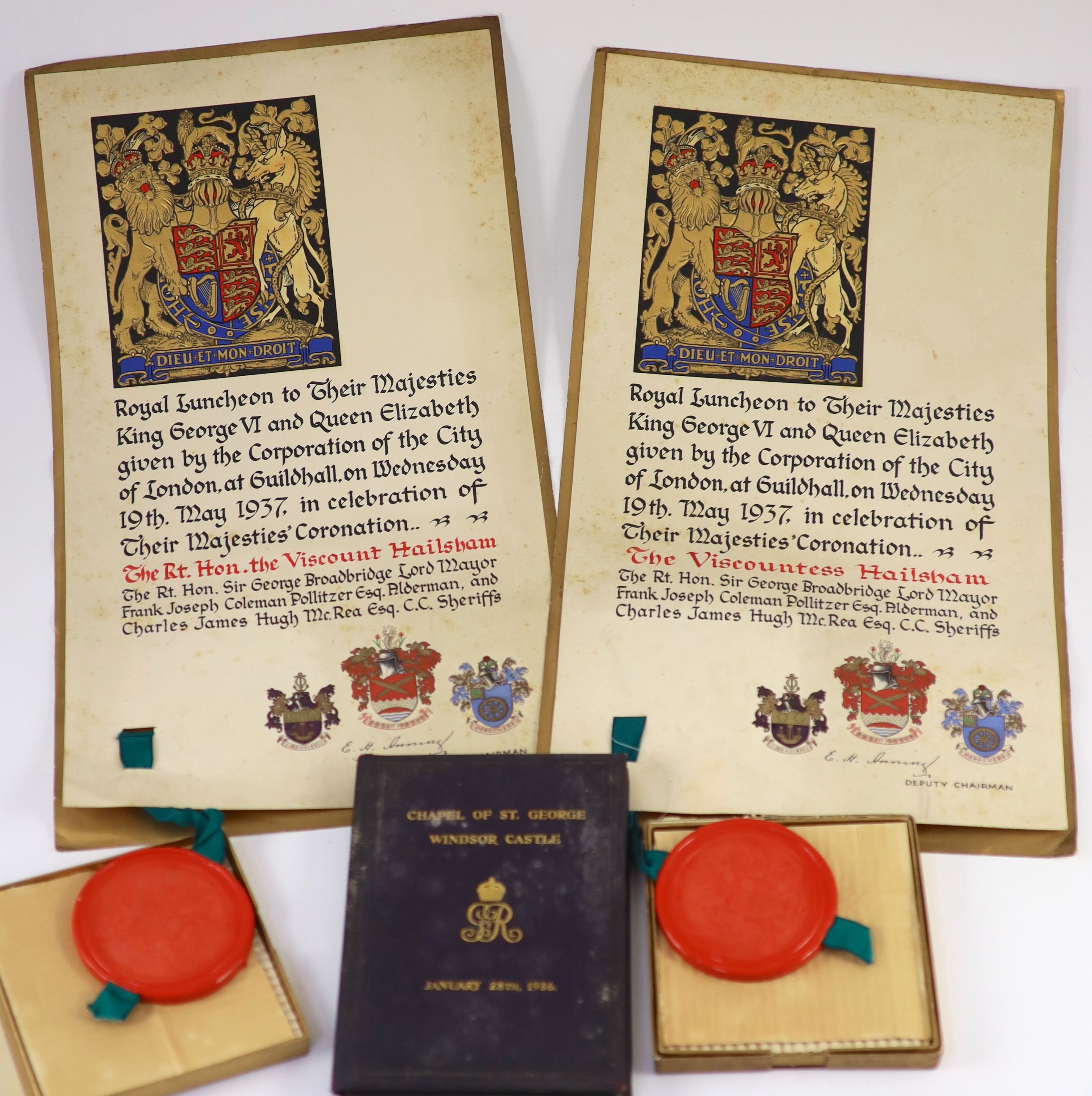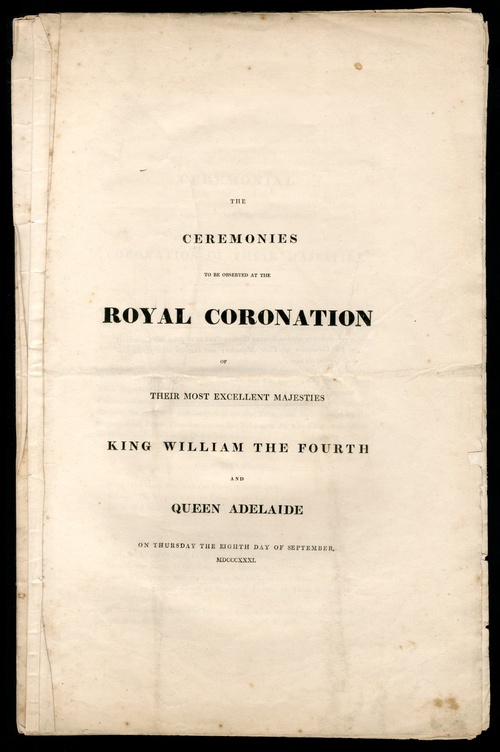7.25 x 11.25 in., plus tab. Signed at top JamesR in bold letters. Whitehall, dated 23th March 1684/5. Addressed to Viscount Townesend ("Cousin"), this is an order (not an invitation) for he and his wife to attend the coronation of James and his wife as James II of England and Ireland (he was also James VII of Scotland). Right Trusty and Welbeloved Cousin Wee greet you well. Whereas Wee have appointed the 23th day of April next for the Solemnity of Our Royal Coronation, These are therefore and to will and Command you, all excuses set apart, that you make your personal attendance on Us at the time abovementioned, furnished and appointed as to your Rank and Quality appertemeth, there to do and performe such services as shall bee required and belong unto you. And whereas Wee have also resolved, that the Coronation of Our Royall Consort the Queen shall be solemnized on the same day, Wee do further hereby require the viscountess, your wife to make her personal attendance on Our said Royall Consort at the time and in the manner aforesaid, Whereof you and she are not to fail. And so Wee bid you heartily farewell. Given at Court at Whitehall the 23th day of March 1684/5 in the first year of our Reigne. James (1633-1701) was the second son of Charles I. James grew up during an era of distrust between Catholic and Protestant, and between Parliament and the monarchy. During the English Civil War, James escaped imprisonment and fled to Europe. When his father was executed in 1649, his older brother was declared king by the monarchists. Although Charles II was recognized by Scotland and Ireland, he never secured the crown of England, and fled to France where James joined him. James served in the French army in the Franco-Spanish War. Charles entered into an alliance with Spain, resulting in both he and James being expelled from France. James fought with Charles over his snub of their French hosts, and later joined the Spanish army (in part because he was destitute), fighting against his former brothers-in-arms. The primary significance of these events is that during his time in Spain, James lost contact with his Anglican advisers, became friends with several Catholics, and converted to Catholicism. Charles was eventually restored to the throne. Eventually, James' conversion to Catholicism became known. After James' first wife, Anne (who had converted with him), died, James married Mary of Modena, a Catholic Italian royal. As one condition of the marriage, Charles mandated that James' daughters by Anne, Mary and Anne, be raised Protestant. Charles later arranged for Mary to marry her cousin, William of Orange, also a Protestant, against the wishes of James. When Charles died in in 1685 leaving no legitimate children, James succeeded him on the throne, having (temporarily) regained some sympathy after a plot to assassinate the monarchs - Protestant as well as Catholic - and reestablish a Cromwellian-style government was uncovered. Crowned in 1685, as soon as could be arranged after Charles' death, James and Mary would not hold the throne for long. Relatives and others in power would have been ordered to attend the coronation as a show of support (and to swear allegiance to the new king). Rebellions constantly erupted or threatened, plots against the king were numerous. In part in response to these, James attempted to consolidate power and reestablish an absolute monarchy. The birth of a Catholic son and heir finally pushed a group of Protestant nobles to invite William of Orange to invade and give England a Protestant ruler (through James' eldest daughter, Mary). This "Glorious Revolution" eventually caused James to flee to France in 1688. He attempted to return a year later, with French assistance, landing in Ireland, but was ultimately defeated and returned to France to live out his days (though not without some intrigue yet). Framed and glazed with a print of James, 21 x 25 in. With COA and wax seal of Charles Hamilton on verso. Condition:
7.25 x 11.25 in., plus tab. Signed at top JamesR in bold letters. Whitehall, dated 23th March 1684/5. Addressed to Viscount Townesend ("Cousin"), this is an order (not an invitation) for he and his wife to attend the coronation of James and his wife as James II of England and Ireland (he was also James VII of Scotland). Right Trusty and Welbeloved Cousin Wee greet you well. Whereas Wee have appointed the 23th day of April next for the Solemnity of Our Royal Coronation, These are therefore and to will and Command you, all excuses set apart, that you make your personal attendance on Us at the time abovementioned, furnished and appointed as to your Rank and Quality appertemeth, there to do and performe such services as shall bee required and belong unto you. And whereas Wee have also resolved, that the Coronation of Our Royall Consort the Queen shall be solemnized on the same day, Wee do further hereby require the viscountess, your wife to make her personal attendance on Our said Royall Consort at the time and in the manner aforesaid, Whereof you and she are not to fail. And so Wee bid you heartily farewell. Given at Court at Whitehall the 23th day of March 1684/5 in the first year of our Reigne. James (1633-1701) was the second son of Charles I. James grew up during an era of distrust between Catholic and Protestant, and between Parliament and the monarchy. During the English Civil War, James escaped imprisonment and fled to Europe. When his father was executed in 1649, his older brother was declared king by the monarchists. Although Charles II was recognized by Scotland and Ireland, he never secured the crown of England, and fled to France where James joined him. James served in the French army in the Franco-Spanish War. Charles entered into an alliance with Spain, resulting in both he and James being expelled from France. James fought with Charles over his snub of their French hosts, and later joined the Spanish army (in part because he was destitute), fighting against his former brothers-in-arms. The primary significance of these events is that during his time in Spain, James lost contact with his Anglican advisers, became friends with several Catholics, and converted to Catholicism. Charles was eventually restored to the throne. Eventually, James' conversion to Catholicism became known. After James' first wife, Anne (who had converted with him), died, James married Mary of Modena, a Catholic Italian royal. As one condition of the marriage, Charles mandated that James' daughters by Anne, Mary and Anne, be raised Protestant. Charles later arranged for Mary to marry her cousin, William of Orange, also a Protestant, against the wishes of James. When Charles died in in 1685 leaving no legitimate children, James succeeded him on the throne, having (temporarily) regained some sympathy after a plot to assassinate the monarchs - Protestant as well as Catholic - and reestablish a Cromwellian-style government was uncovered. Crowned in 1685, as soon as could be arranged after Charles' death, James and Mary would not hold the throne for long. Relatives and others in power would have been ordered to attend the coronation as a show of support (and to swear allegiance to the new king). Rebellions constantly erupted or threatened, plots against the king were numerous. In part in response to these, James attempted to consolidate power and reestablish an absolute monarchy. The birth of a Catholic son and heir finally pushed a group of Protestant nobles to invite William of Orange to invade and give England a Protestant ruler (through James' eldest daughter, Mary). This "Glorious Revolution" eventually caused James to flee to France in 1688. He attempted to return a year later, with French assistance, landing in Ireland, but was ultimately defeated and returned to France to live out his days (though not without some intrigue yet). Framed and glazed with a print of James, 21 x 25 in. With COA and wax seal of Charles Hamilton on verso. Condition:
/93756/Internet%20Image%201.jpg)



.jpg)
/112158/Internet%20Image%201.jpg)



/116598/Internet%20Image%201.jpg)

/85380/Internet%20Image%201.jpg)

/77758/Internet%20Image%201.jpg)

Try LotSearch and its premium features for 7 days - without any costs!
Be notified automatically about new items in upcoming auctions.
Create an alert